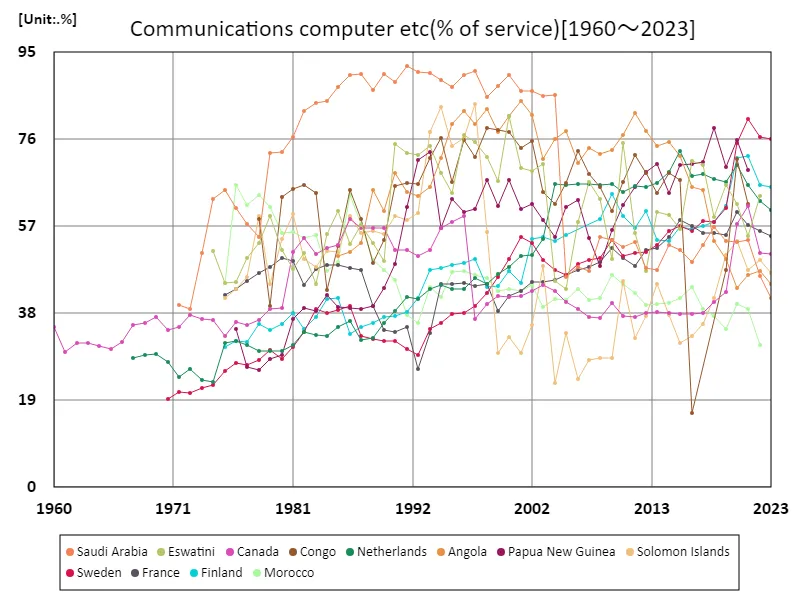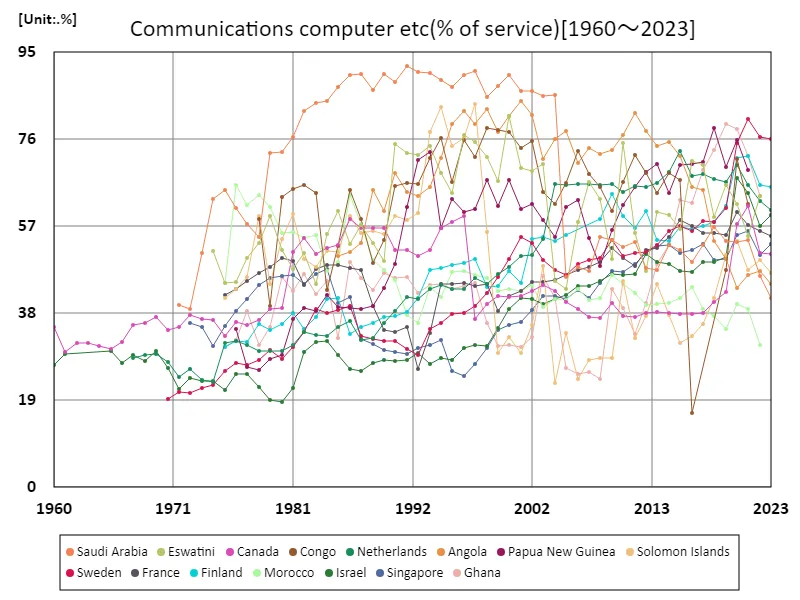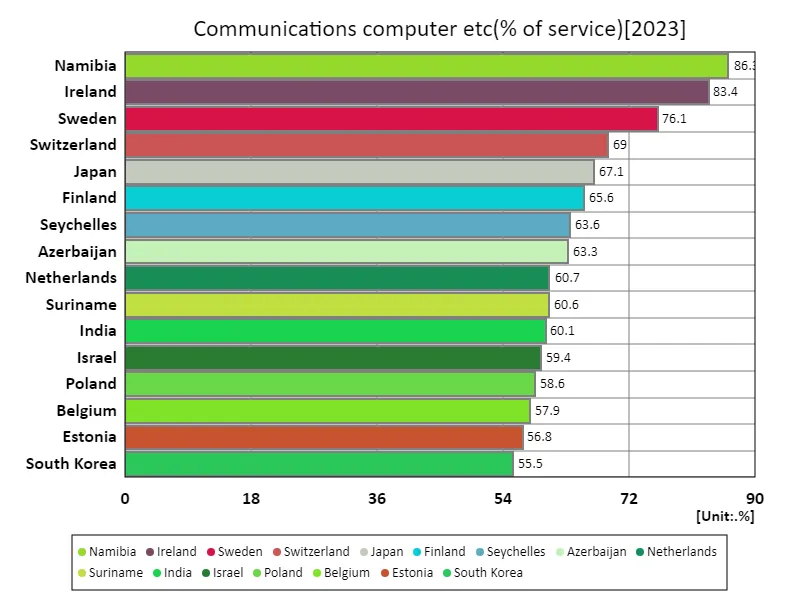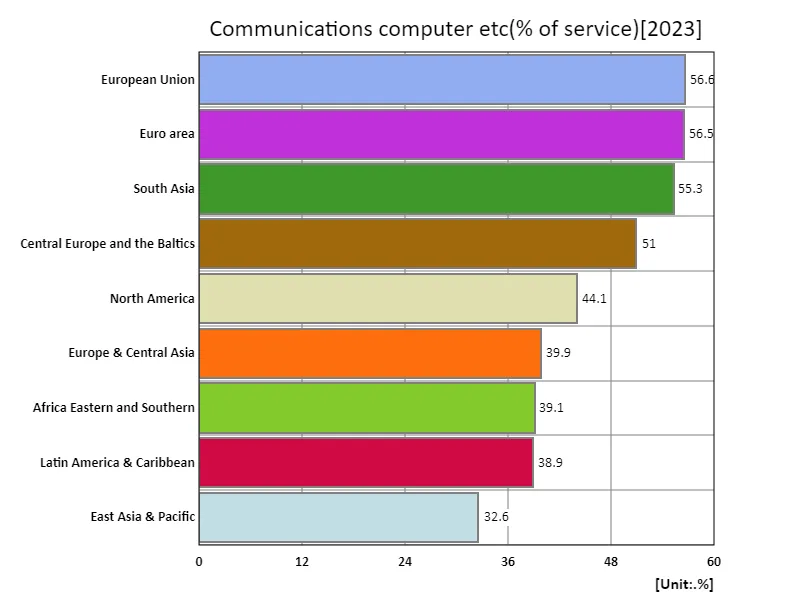Abstract
Data on communications, computers, etc. (service ratio) reflects the effects of changes in each country’s economic structure and technological innovation. Sweden has the highest figure of 76.1% for 2023, highlighting the country’s reliance on the digital economy and the service industry. Over the past few decades, developed countries have been shifting from manufacturing to services, particularly in the IT and communications sectors, and this trend is no exception in Sweden. With the advancement of digitalization, the importance of communication infrastructure and computer technology is increasing, leading to a higher service ratio. This is due to the influence of economic globalization and digitalization, coupled with the growth of knowledge-intensive industries. Other countries are showing similar trends, but Sweden’s high rates are rare.
Communications, computers, etc (service ratio)
Looking at the data from 1960 to 2023, communications, computers, etc. (service ratio) shows the economic growth and changes in industrial structure of each country. The reason why Saudi Arabia recorded a high ratio of 92% in 1991 is likely due to the rapid economic growth driven by oil revenues at that time, as well as a sharp increase in investment in communications and IT. However, Saudi Arabia is now down significantly at 45%. This change can be seen as a result of efforts to diversify the economy and move away from dependency on oil. In recent years, Saudi Arabia has been increasing its investment in other sectors, such as tourism and manufacturing, and the proportion of investment in communications and computers has declined relatively. On the other hand, in developed countries, this ratio is increasing due to the expansion of the digital economy, with the communications and IT sectors becoming an important part of the economy. Overall, communications, computers, etc. (services ratio) has been highly dependent on a country’s economic strategy and technological innovation, and has changed over time.


The maximum is 92%[1991] of Saudi Arabia, and the current value is about 45%
Communications, computers, etc (service ratio) (nationwide)
Data on communications, computers, etc. (service ratio) is an important indicator showing the progress and changes in each country’s economy. Looking at data from 1960 to 2023, Saudi Arabia’s high ratio of 92% in 1991 reflects the rapid growth in oil revenues and the associated expansion of investment in telecommunications infrastructure at the time. During this period, oil revenues pumped abundant funds into the communications sector, making it an extremely high sector. However, Saudi Arabia’s share has since fallen sharply and is now at 45%. The change reflects Saudi Arabia’s economic diversification and industrial shift. In recent years, the country has moved away from its reliance on oil and is increasing investment in tourism, manufacturing and emerging industries. As a result, the proportion of communication computers, etc. decreased relatively. On the other hand, in developed countries, the development of digital technology and the expansion of the service industry are progressing, and the proportion of communications computers, etc. is increasing. The ratio is increasing as these countries see the development of IT infrastructure and the focus of economic activity shift toward the service sector. Overall, the communications/computers, etc. (services ratio) is strongly influenced by a country’s economic strategy and changes in industrial structure, and can be said to be an important indicator reflecting the economic situation of each country.


The maximum is 92%[1991] of Saudi Arabia, and the current value is about 45%
Communications, computers, etc (compared to services) (World countries, latest year)
According to data from 2023, Namibia recorded the highest ratio of communications, computers, etc. (services ratio) at 86.3%, indicating that the country is focusing on developing digital infrastructure and has an extremely high proportion of the service industry. This high ratio is a result of Namibia devoting significant resources to the information technology and communications sector, positioning it as a major part of the economy. On the other hand, the global average is 39.1%, which shows that many countries keep the ratio of communications computers, etc. relatively low. This reflects the need to maintain a balance with other industries even as communication technology continues to develop. In addition, the figure ”total 4.34k%” indicates that the overall data is the sum of multiple countries or regions, and is not a simple average but an indicator for understanding the overall trend. Fluctuations in each country’s communications, computers, etc. (services ratio) are greatly influenced by technological innovation, economic policies, and changes in industrial structure, so through this data it is possible to grasp the development status of each country’s digital economy and trends in the strengthening of the service industry.


The maximum is 86.3% of Namibia, the average is 39.1%, and the total is 4.34k%
Communications, computers, etc (comparison of services) (region, latest year)
According to data from 2023, the highest value for communications, computers, etc. (services ratio) is in the European Union (EU) at 56.6%, indicating that the EU is at the forefront in the development of the digital economy. This high ratio reflects the EU’s strong technological capabilities, strong communications infrastructure, and a service-based economy. Given that the global average is 46%, while many countries have a certain ratio for communications computers, etc., we can see that the overall level is average. This shows that while digital technology is becoming more widespread, there are variations in the ratio due to differences in industrial structure and economic policies in each country. The figure ”total of 414%” is an aggregate of data from multiple countries and regions and is used to understand overall trends as the sum of the individual data points. Overall, the Communications, Computers, etc. (services ratio) is an indicator that reflects countries’ technological maturity and the progress of the digitalization of their economies, and the high ratio in the European Union in particular highlights the strengthening of the region’s digital infrastructure and the importance of the service industry.


The maximum is 56.6% of European Union, the average is 46%, and the total is 414%



Comments